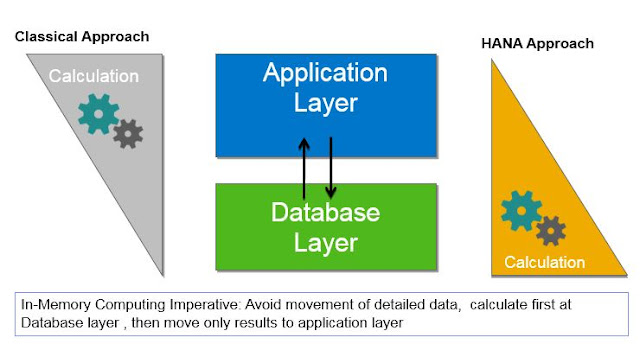Underlying Technology Behind SAP HANA - Hardware & Software
SAP Business Suite on HANA(BsOH), powered by SAP HANA brings together OLTP and OLAP worlds into a single in-memory platform, and helps Suite of Applications like ERP, CRM and SCM to manage their Business processes with improved Performance.
It helps Customers to quickly Optimize, Execute, and Align their business and IT strategies and also gives unique ability to allow real-time reporting, and analysis across their end-to-end business processes. The Underlying HANA Platform helps to provide these innovations without disruption.
Because of its in-memory approach, SAP HANA enables both hardware and software innovations which are unparalleled, replacing traditional databases in many spheres of business world! On the hardware side, SAP HANA facilitates Multi-Core Architecture (8×8 core CPU per blade), huge parallel scaling with several blades, 64 bit address space – 6 TB in current servers, data throughput as high as 100 GB/s, cost effectiveness and so on.
On the software side, SAP HANA enables columnar data storage, partitioning, compression, eliminating aggregate tables, to name a few.
SAP HANA has the following H/w Innovations:
- Multi-core CPUs are now an Industry standard. This ensures fast communication between processor cores and hence enables Parallel processing.
- Main memory is no longer a limited resource , and modern servers can now can have upto 6 TB in current servers, this means the entire database can now be loaded on to main memory.
- Increased data throughput of 100GB.
SAP HANA has the following S/w Innovations:
- SAP HANA has row and column store (column store aids in Compression, accelerates analysis on small no. of columns and enables parallel processing).
- Data Compression - Allows large data to be stored in an efficient manner.
- Partitioning - Table contents are stored across diff blades ( partitions).
Basic Difference Between ABAP & ABAP On HANA
Classical approach was:
- To keep load from the database.
- Get all data that is needed from database on the application server.
- And do processing in ABAP (i.e. in Application layer).
But, to benefit the most from HANA capabilities, the new HANA approach would be:
- Expensive calculations and aggregations to be done in HANA database itself rather than moving all this data to Application layer.
- And transfer only the results to the Application layer.
This becomes a fundamental change in the ABAP Programming and hence becomes a Paradigm shift

